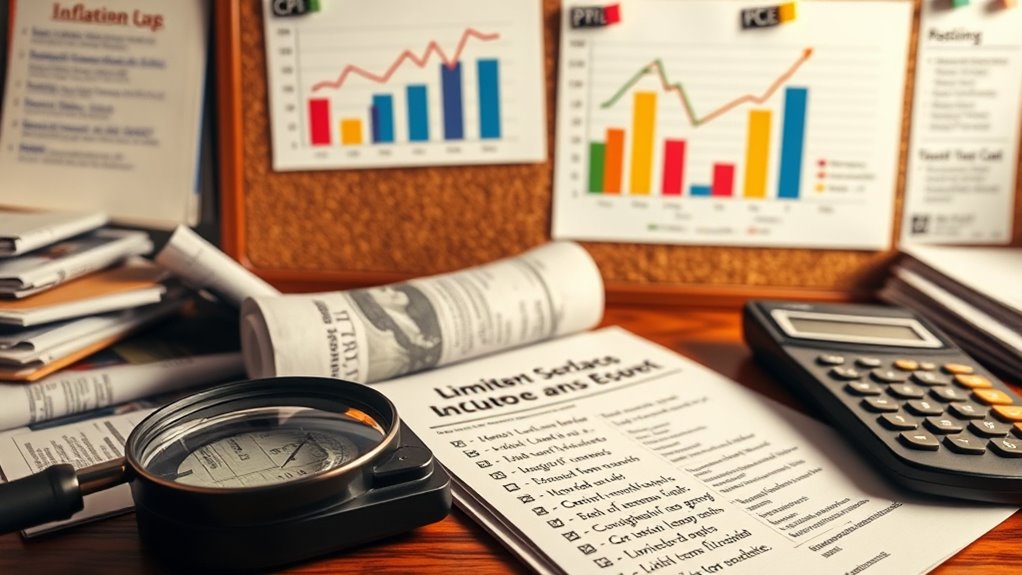Inflation indexes like CPI and PCE help you understand how prices for goods and services change over time. CPI tracks fixed basket items households buy, while PCE adjusts for changing habits and includes healthcare and other services. Both help policymakers and businesses make decisions, but they differ in scope and flexibility. Knowing how these indexes work can clarify economic trends, and exploring further will give you a clearer picture of their roles and limitations.
Key Takeaways
- CPI uses a fixed basket based on household surveys, while PCE adjusts its basket over time for better accuracy.
- PCE is preferred by policymakers due to its broader scope, including healthcare and services, compared to CPI.
- Both indexes measure inflation but differ in data sources, weighting methods, and responsiveness to consumer behavior.
- Limitations such as substitution effects, quality changes, and data gaps can affect the accuracy of both indexes.
- Understanding these differences helps interpret inflation data and informs economic decision-making effectively.
What Are Inflation Indexes and Why Are They Important?
Inflation indexes measure how prices for goods and services change over time, providing a clear picture of inflation’s impact on the economy. They help you understand whether prices are rising, falling, or staying stable, which influences your purchasing power. Governments, businesses, and consumers rely on these indexes to make informed decisions. For example, policymakers use them to decide on interest rates or fiscal policies, while companies adjust wages and prices accordingly. If inflation is too high, it can erode savings and reduce the value of money. Conversely, low or negative inflation signals economic stagnation. By tracking these indexes, you gain insight into economic health, helping you plan budgets, investments, and spending habits more effectively. Additionally, understanding the methods used in index calculation helps you interpret economic reports more accurately, especially given the influence of AI in economic analysis on modern data processing. Recognizing inflation measurement techniques can also improve your ability to anticipate economic shifts. Ultimately, inflation indexes are essential tools for managing economic stability.
How Is the Consumer Price Index (CPI) Calculated?

Have you ever wondered how the Consumer Price Index (CPI) is calculated? The CPI measures the average change over time in the prices paid by consumers for a market basket of goods and services. Here’s how it works:
- Selecting a basket: Experts choose a representative group of products people regularly buy. This selection process considers consumer spending habits to ensure accuracy.
- Collecting prices: They gather price data from various stores and service providers.
- Calculating price changes: Using the data, they determine how much prices have increased or decreased.
- Creating the index: These changes are combined into a single number that reflects overall inflation.
- Using home decor items like wall organization systems can influence the prices of household goods included in the basket.
This process helps track how everyday expenses fluctuate, giving you a clear picture of inflation’s impact on your wallet.
Understanding the Personal Consumption Expenditures (PCE) Price Index

While the Consumer Price Index (CPI) provides a snapshot of price changes based on a fixed basket of goods, the Personal Consumption Expenditures (PCE) Price Index offers a broader view of consumer spending trends. The PCE index tracks the prices of goods and services that households actually purchase, including changes in quantities and substitutions. It uses an adaptable basket that adjusts over time, reflecting real-world buying habits, and this dynamic adjustment helps improve its accuracy. This index is favored by policymakers because it captures a more extensive picture of inflation. It considers a wider range of items and updates weights regularly to mirror current consumption patterns. Additionally, the PCE’s methodology helps account for toilet flush efficiency and changing consumer behaviors, making it a more comprehensive measure of inflation’s impact on consumers and the economy as a whole. Moreover, the PCE incorporates household expenditure data, which enhances its ability to reflect true consumer experiences and align with income tax brackets influencing retirement planning.
Comparing CPI and PCE: Key Differences and Uses

You should understand that the CPI and PCE differ in how they measure price changes, with each using distinct data collection methods. These differences influence how policymakers rely on them to guide economic decisions. Recognizing their specific uses helps you grasp why both indexes are essential in tracking inflation. For example, remote hackathons have become increasingly popular, allowing global teams to collaborate virtually and expand access to diverse talent.
Measurement Methodology Differences
The Consumer Price Index (CPI) and the Personal Consumption Expenditures (PCE) price index differ considerably in their measurement methods, which affects how each captures inflation. You’ll notice that CPI relies more on fixed baskets of goods and services, representing what consumers buy now. In contrast, PCE adjusts for changing consumer habits over time, capturing a broader range of expenditures.
- CPI uses a fixed basket; PCE updates it regularly
- CPI weights are based on surveys; PCE uses business data
- PCE accounts for substitution effects more effectively
- CPI focuses on out-of-pocket expenses, PCE includes employer-covered costs
These methodological differences influence their sensitivity and accuracy in tracking inflation trends.
Policy and Economic Uses
Have you ever wondered how policymakers decide whether the economy is overheating or slipping into a recession? CPI and PCE are key tools for this. They help gauge inflation’s impact on consumer spending, wages, and interest rates. Policymakers prefer PCE for its broader scope and frequent updates, making it more responsive to economic shifts. CPI, however, is often used for adjusting social security and tax brackets. Understanding their differences helps you grasp how decisions like interest rate changes or stimulus packages are made.
| Feature | CPI | PCE |
|---|---|---|
| Focus | Consumer prices in fixed basket | Overall consumer spending and substitution |
| Frequency | Monthly | Monthly |
| Use in policy | Less frequent, targeted | Preferred for Federal Reserve decisions |
| Scope | More limited | Broader, includes healthcare and services |
How Inflation Indexes Influence Economic Policy and Daily Life

Inflation indexes play a crucial role in shaping economic policies and affecting daily life because they provide a standardized measure of how prices change over time. When policymakers see rising CPI or PCE figures, they might decide to adjust interest rates to control inflation or support economic growth. These indexes also influence cost-of-living adjustments for wages, pensions, and social benefits, helping guarantee your income keeps pace with inflation. Additionally, understanding the psychological impact of inflation indexes can help individuals better navigate financial decisions during periods of economic change. You’ll notice their impact in everyday decisions, like setting rent increases or grocery prices. They also guide businesses on pricing strategies and investment plans. Fundamentally, inflation indexes help both the government and individuals make informed choices, keeping the economy stable and your finances aligned with current economic conditions. Recognizing how economic indicators influence policy can empower consumers and investors to make more informed decisions. Furthermore, being aware of the comparative advantage principle enhances understanding of how countries adapt economically to global shifts.
Limitations and Criticisms of Inflation Measures

You should be aware that inflation measures can be affected by price bias, which occurs when certain goods’ prices don’t reflect true changes, and substitution bias, where consumers switch items but indexes don’t. Coverage gaps also exist, leaving out some products or services that influence your cost of living. These limitations can distort the actual inflation you experience and challenge the accuracy of these measures. Additionally, cybersecurity vulnerabilities can impact economic data collection and reporting, further complicating inflation measurement. Recognizing the methodological differences among various inflation indexes is essential for understanding their respective limitations and interpretations. Moreover, the reliance on AI security in safeguarding economic data underscores the importance of robust cybersecurity practices in maintaining data integrity. Understanding the data collection methods used by agencies can help interpret inflation figures more accurately.
Price Bias and Substitution
One major criticism of inflation measures is their tendency to introduce price bias and substitution effects that can distort true cost changes. When prices fluctuate, consumers often switch to cheaper alternatives, but indexes may not fully capture this behavior. As a result, the reported inflation rate might underestimate actual changes in living costs. This measurement limitation can lead to misinformed policy decisions and misleading inflation forecasts. To understand this better, consider:
- Fixed baskets may ignore new or cheaper products you buy
- Substitution effects are not always reflected promptly
- Consumer habits shift faster than data updates
- Quality improvements can be overlooked, skewing results
These issues highlight how inflation measures, while useful, have limitations that can impact their accuracy in reflecting real-world price changes.
Coverage and Data Gaps
Despite their widespread use, inflation measures often suffer from coverage limitations and data gaps that can undermine their accuracy. These indexes rely on surveys and sampling methods that may miss important consumer behaviors or regional variations. For example, they might not fully capture emerging products, new technology, or changes in consumption patterns. Additionally, some categories, like housing or healthcare, can be difficult to measure precisely due to data delays or inconsistent reporting. As a result, inflation figures could underestimate or overestimate actual price changes faced by consumers. Moreover, essential data collection issues can hinder the ability of these indexes to reflect real-time price movements accurately. Recognizing these limitations helps you understand that CPI and PCE are useful tools, but not perfect representations of the true inflation experience. Data collection methods also influence the reliability of these indexes, as outdated or infrequent surveys can skew results. These gaps can lead to misinformed policy decisions or misinterpretations of economic health.
Frequently Asked Questions
How Often Are Inflation Indexes Like CPI and PCE Updated?
You might wonder how often inflation indexes like the CPI and PCE are updated. Typically, the Consumer Price Index (CPI) is released monthly, providing recent data on consumer prices. The Personal Consumption Expenditures (PCE) price index is updated quarterly, offering a broader view of inflation trends. Regular updates help you stay informed about changes in the cost of living and economic health, guiding your financial decisions effectively.
Which Inflation Index Is Preferred for Wage Negotiations?
For wage negotiations, you should prioritize the Consumer Price Index for Urban Consumers (CPI-U). It’s widely used and reflects the cost of living for most workers. CPI-U’s monthly updates give you timely data to adjust wages accordingly. While the Personal Consumption Expenditures (PCE) index is also important, CPI-U’s familiarity and direct relevance make it the preferred choice in negotiations, helping you guarantee wages keep pace with inflation.
Do Inflation Indexes Account for Regional Price Differences?
You might wonder if inflation indexes consider regional price differences. Generally, standard indexes like CPI and PCE don’t fully account for regional variations, as they use national averages. However, some specialized indexes or regional data exist to reflect local costs more accurately. If you’re comparing inflation impacts across areas, look for regional-specific measures or adjust national figures to better understand how prices change locally.
How Do Seasonal Adjustments Impact CPI and PCE?
Seasonal adjustments modify the CPI and PCE to remove fluctuations caused by seasonal patterns, like holidays or weather changes. This way, you get a clearer picture of underlying price trends without short-term noise. These adjustments help you compare month-to-month or year-to-year data more accurately, ensuring you’re not misled by predictable seasonal swings. Overall, seasonal adjustments make inflation data more reliable and easier to interpret.
Can Inflation Indexes Predict Future Economic Downturns?
Think of inflation indexes like a weather vane—they hint at changes ahead. While they can signal economic shifts, they don’t predict downturns with certainty. Rising CPI or PCE might warn of inflation pressures, but they don’t guarantee a recession. You should watch these indexes alongside other indicators to get a clearer picture. Relying solely on them can be like trusting a single cloud to forecast the storm.
Conclusion
Now that you understand how CPI and PCE measure inflation, you might wonder how these figures really impact your everyday life. Do they truly reflect the cost changes you experience? By grasping these indexes, you can better interpret economic news and make smarter financial decisions. Isn’t knowing what drives inflation enough to empower you in steering today’s complex economy? Stay informed, stay prepared—your financial future depends on it.









